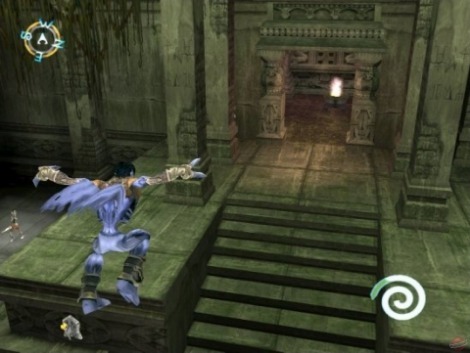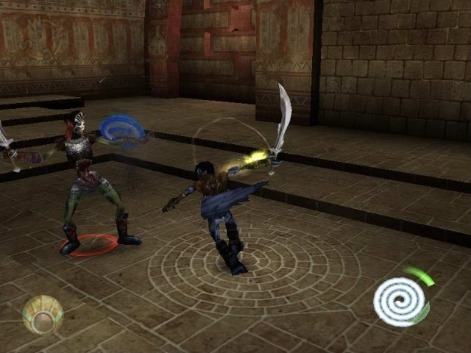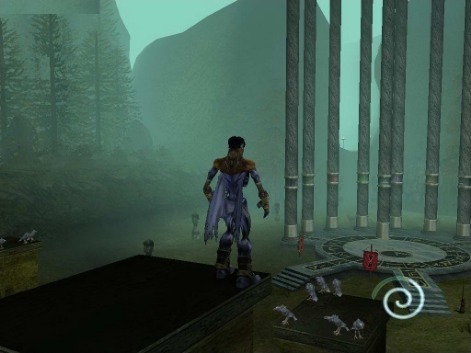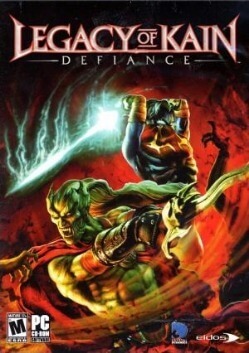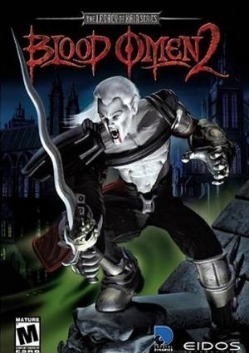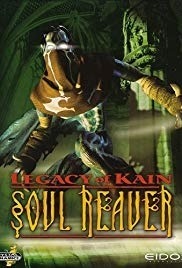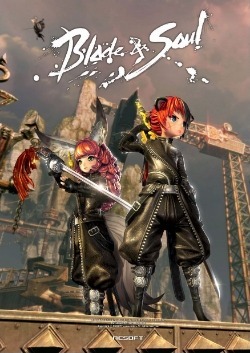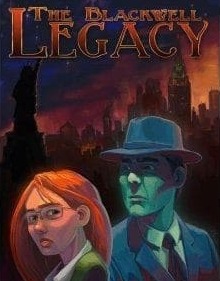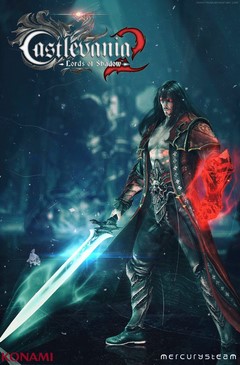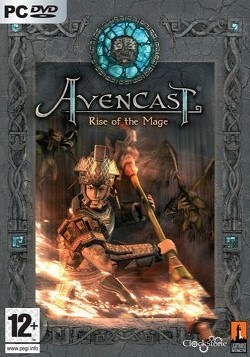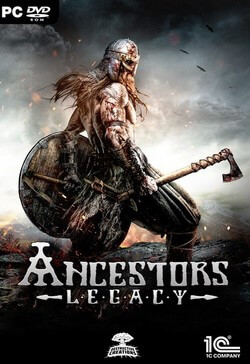Raziel retains most of the powers he possessed in the previous game, such as the abilities to glide, climb walls, fire bolts of telekinetic energy, and swim. To sustain his strength and travel between the planes, he must devour souls; this is typically accomplished by defeating enemies. The game's combat consists of a hack and slash system, entailing the use of combinations of attacks before executing a finishing move. Human enemies exist only in the material world, and include mercenaries, demon hunters, and the Sarafan, a monastic order of vampire hunters; other material creatures include dogs, thralls, and mutants. Sluagh are enemies who exclusively inhabit the spirit world, whereas cross-planar beings such as demons and shades can pursue the player between both realms. Enemies leave behind souls when killed, which replenish Raziel's health once consumed.
The player's primary weapon is a ghostly version of the Soul Reaver sword, referred to as the wraith-blade. The wraith-blade is symbiotically bound to Raziel, and can be summoned or dismissed at any time in the material world, but, if overused, the sword can turn against Raziel, siphoning his health. Other weapons include claws, swords and spears. As the game progresses, the player encounters magical forges which imbue the wraith-blade with elemental powers associated with darkness, light, air, and fire. These enhancements have various uses, but are only available in the material realm. If Raziel shifts, he loses his active elemental imbuement, and must re-forge the blade at locations scattered throughout the game world.
Development
Even before the release of Soul Reaver, Crystal Dynamics were aware that they would create a follow-up, but had no "master plan". Soul Reaver uses the engine of Gex: Enter the Gecko. Prior to the beginning of development, director Amy Hennig emphasized that the role-playing game elements of Blood Omen, stronger dialogue and character interaction, a greater variety of acquirable mechanics, and wider use of the spectral realm should figure into the sequel. Pre-production began in late 1999, and the project briefly entered development for the PlayStation and Dreamcast with a targeted release date in fall of 2000. The team was given approval to switch to the PlayStation 2 after creating a proof-of-concept demo for E3 2000, and the game was announced as an console exclusive title for the PlayStation 2, dropping the Dreamcast and original PlayStation versions in the process. Executive producer Andrew Bennett analogized the developers' design sensibilities to the non-linear nature of Nintendo's The Legend of Zelda and Mario franchises, but said it was decided that Soul Reaver 2 would not be a "traditional 'complete a level, fight a boss' type of game". Level designers constructed a generalized puzzle and object-interaction system, helping to prevent an undesired re-emergence of Soul Reaver's abundant block puzzles. Instead of creating more inherent and optional abilities for Raziel, they focused on including new, mandatory enhancements for the Soul Reaver weapon.
On the decision to downplay Raziel's quest for vengeance against Kain in this sequel, Hennig explained, "he's being pretty simple-minded, he's sort of being very black-and-white in his interpretation of things, and being kind of petulant ... he's not really as heroic as Kain is, and he has a lot of stuff to figure out, basically, about what's going on". Soul Reaver 2 was crafted to feature a more cinematic, story-focused experience than its predecessor, which the developers felt had been "patchy" in this regard. It entered production after Blood Omen 2, but shipped almost six months before the latter game. A separate team within Crystal Dynamics, with creative autonomy, developed Blood Omen 2, and contradictions created by its scenario hindered work on Soul Reaver 2. After researching time travel fiction, Hennig devised a subplot concerning temporal paradoxes to resolve the continuity problems between both titles, and established that Blood Omen 2's story is a product of the final paradox created when Kain saves Raziel at the end of Soul Reaver 2. Other themes were inspired by the works of Joseph Campbell, and theology surrounding Gnosticism. Concepts which formulated the crux of the story included the idea "that the only way a hero can ever succeed is by following his own path", and the question, "can you change history or not? And if so, what does it mean to change history - in terms of being responsible for the repercussions?"
British comic book writer Paul Jenkins was drafted by Crystal Dynamics to help refine the game's script. Though Soul Reaver features a variety of boss encounters, Soul Reaver 2 does not; this was a conscious decision on the part of the staff, to ensure the game's pacing more closely emulated that of a novel or a film, although near the end of the game, the Sarafan commanders including Raziel's human self are considered somewhat as a "bosses" since they are more challenging than the usual enemies during the game. While expanding the series' fiction, Hennig sought to take people back to the characters and mythology of the original Blood Omen, and built on its latent themes, including issues of fatalism, ethical dilemma and morality. In an interview, she stated that "the game will have a proper ending this time", and said "it has a conclusion. It's the end of a chapter. There won't be a cliffhanger". However, the story needed to be restructured several times before its completion, and, like the original Soul Reaver, many planned areas and abilities were excised, including three elemental forges (earth, water and spirit), more Reaver enhancements, and nine "spell-type things". She explained that the project's small programming crew, its switch to the PlayStation 2, and its limited 17 month production schedule had forced the team to "pick their battles", leading numerous features to be simplified or eliminated. Commenting on the final product, lead designer Richard Lemarchand said that Soul Reaver 2 "fell short of what the team had wanted to accomplish. In particular, some puzzles were too opaque, the combat was rather one-dimensional, and the story ended without a decent resolution".






